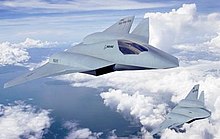Requirements
Air superiority fighter with multi-role capabilities

In April 2012, the Navy issued a formal request for information for the F/A-XX. It calls for an air superiority fighter with multi-role capabilities to initially complement and eventually supersede the F/A-18E/F Super Hornet and EA-18G Growler aircraft in the 2030s, while complementing the F-35C Lightning II and UCLASS unmanned aircraft, that can operate in anti-access/area denial environments. Primary missions include air combat, air to air, ground attack, surface warfare, and close air support. Platform requirements include supercruise capabilities as well as advanced next-generation stealth features, sensors and radars with networking adaptability. Additional missions and capabilities include air-to-air refueling, reconnaissance, surveillance, and target acquisition (RSTA), and electronic warfare and countermeasures thereof. Manned, unmanned, and optionally-manned operations for a highly adaptive platform will be part of the new system.[4] The F/A-XX is being pursued as F/A-18 Super Hornets will reach the end of their 9,000 hours of service life by the early 2030s. Aside from the option of buying more F-35Cs, the F/A-XX is seeking to create a new aircraft to replace the Super Hornet's capability and mission set. Just as the F-35C replaced aging F/A-18 Hornets and complements Super Hornets, the F/A-XX will replace aging Super Hornets in the 2030s and complement the F-35C.[5]
Maximum connectivity and sensors
Although the F/A-XX platform will be a sixth-generation fighter aircraft, the Navy is reluctant to talk about a new aircraft because the project is still in the very early stages of development. A range of next-generation technologies may be explored including maximum sensor connectivity, and electronically configured "smart skins". Maximum connectivity refers to massively increased communications and sensor technology, such as having the ability to connect with satellites, other aircraft, and anything providing real-time battlefield information. Smart skins would have sensors and electronics integrated into the fuselage of the aircraft itself to increase sensor performance while reducing drag and increasing speed and maneuverability.[6]
Open architecture
An open architecture design is desired, allowing for different sensors, payloads, and weapons to be used to meet specific mission requirements and be able to be moved around for multiple different missions on different days or different sorties. The resulting open architecture design is likely to take shape depending on which style of new propulsion system is presented by the aircraft industry.
Propulsion
The Navy is working with the U.S. Air Force on a next-generation tactical fighter with super cruise ability. There is significant disagreement over the Air Force's claims that adaptive-cycle jet engine technology, where the ratios of bypass and compression airflow can be made variable to improve efficiency, can benefit a carrier-based fighter.[7][8]
New spectrum of weapons
Chief of Naval Operations Jonathan Greenert speculated in February 2015 that the F/A-XX would not rely primarily on speed or stealth as much as previous-generation jet fighters due to better signature detection and proliferating high-speed anti-aircraft weapons. Instead, in addition to its protective features provided by its stealth features, technologies, maneuverability and speed, the fighter is to carry a wide array of new spectrum of advanced weaponry to overwhelm or suppress enemy air defenses and ensure survivability and superiority. One approach could create a minimum cost F/A-XX that uses high-cost, high-performance weapons to defeat threats; according to the Navy's Naval Integrated Fire Control-Counter Air (NIFC-CA) battle network concept, an individual platform would not need to have a full suite of sensors and rely on off-board data-linked information from other platforms to provide targeting information and guide weapons launched from the platform. The F/A-XX platforms will be made to carry missiles, have power and cooling systems for directed-energy weapons, and have sensors that can target small radar cross-section targets; cyber warfare platforms at a tactical level as part of a family of systems are being explored.
Increased payload
The total payload capacity, range and variety of weaponry and equipment of the F/A-XX will at least match or likely exceed the current platform i.e. Super Hornet's payload capacity and capabilities.[9]
Unmanned
In May 2015, Secretary of the Navy Ray Mabus stated that the F/A-XX should be a platform with the capability of optional unmanned autonomous operation.[10] The effort may produce a family of systems to replace the capabilities of the F/A-18E/F and EA-18G rather than a single airframe, and the Navy is now conducting an analysis of alternatives for their next-generation aircraft in partnership with the Air Force.[11] Greenert favors an optionally manned aircraft for a modular section that can either hold a pilot or more sensors.
Aircraft carrier compatible
The aircraft must be capable of operating from Navy Nimitz-class and Gerald R. Ford-class aircraft carriers.
